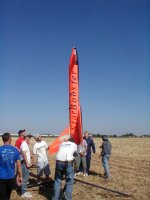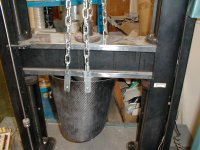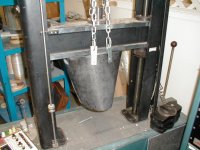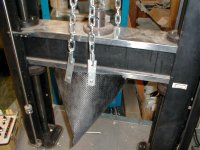That even goes for the heaver honeycomb weave? Also what grade am I looking for (1k 2k 3k etc)? And how many layers need to be applied?Not at all, normal drill bits as used for metal, cut off discs (thin) to cut/shape. Saw blades will shatter or cause internal cracks (not good).
Sounds like disposable haz suit territory.Just remember that carbon fiber is very sharp, so when you cut/drill/shape, those are tiny razor sharp particles. Use every precaution, I have a fan that blows on the work area, my shop vac hose connected to power tools and the BEST respirator I could find.
So a top layer then? If you say the honeycomb is more rigid then that's probably what I'll use.If your looking for the shiney "carbon fiber look" get the polished sheet, it's a very thin sheet more of a finisher than structural.
Use the cheapest one, decide how thick you want, you won't be stressing the material at all! I use honeycomb only when the item will be stressed by 2g's or more, then you need to pay attention to layers and strength figures.That even goes for the heaver honeycomb weave? Also what grade am I looking for (1k 2k 3k etc)? And how many layers need to be applied?
If it was my project, I'd use the shiny sheet (2mm thick) with extruded aluminum 1/16" thick "L" channel with 4mm black button head fasteners to attach the sheet to make an enclosure.So a top layer then? If you say the honeycomb is more rigid then that's probably what I'll use.
So the reason I'm paying attention to rigidity is because this build will have a pair of 8" subs in them. The more rigid it is the less mushy the bass will be. It'll also mean I don't have to count on just mdf which means I can cut down weight as well.Use the cheapest one, decide how thick you want, you won't be stressing the material at all! I use honeycomb only when the item will be stressed by 2g's or more, then you need to pay attention to layers and strength figures.
PVC pipe wouldn't work? I figure that would be a lot easier to use as a form to wrap the fiber around.If it was my project, I'd use the shiny sheet (2mm thick) with extruded aluminum 1/16" thick "L" channel with 4mm black button head fasteners to attach the sheet to make an enclosure.
The sheet has a finished side and a raw side, do all your work (drill/cut) from the raw side to the shiny side and let the tool do the work without you forcing it, so it cuts the finished side as clean as possible. Use a drill press, clamp the work down if drilling or cutting. It's a lot like working with Formica.
I figure that would be a lot easier to use as a form to wrap the fiber around.
The sheet and honeycomb is rigid, it's already been cured, this is NOT raw material, it will not bend around any form. It's like working with sheet aluminum, as apposed to glass fiber or epoxy. You could use the honeycomb with adhesives which are just as strong as the carbon fiber, all the honeycomb I use is without a polished finished side. It looks great on a race car, not sure about a sub enclosure, it's very industrial looking.
If your thinking of a sealed enclosure for a sub, your beyond my DIY ability, you will need to contact fabricators. Be prepared for the cost. Or build the enclosure with wood and use the thin sheet as a finisher laminate.
There's actually a few folks here who I could probably ask. @Mark Tillotson and @weltersys are the first two that come to mind.If your thinking of a sealed enclosure for a sub, your beyond my DIY ability, you will need to contact fabricators. Be prepared for the cost. Or build the enclosure with wood and use the thin sheet as a finisher laminate.
A composite layup refers to the layers of reinforcement material, the most basic of which would be something Like "X number layers of 5.6oz plain weave fiberglass". Fiberglass, kevlar, carbon fiber etc, different can be combined for their material properties or fiberglass may be the primary reinforcement with carbon fiber used as the final layer or two for visual effect. In advanced composites, the layups can be highly technical constructions with materials of varying weiSo I wouldn't need a mold or anything?
Also, what exactly is a layup? If you want electronics help I can do that pretty well but on handling CF not so much 😅
The most experience I have there is a few youtube videos and a post by @fredygump lol
I was suggesting that you may want to use pvc pipe as a mold. Some CF/kev hybrid fabrics look great btw
Edit to add: a number of different weave types are available and they possess differing properties and appearance
Ok so there are ways to layer them in order to change their physical properties. So during a layup, how do you layer them? If it's anything like fiberglass I know that you still have frayed ends to contend with (I used to do pipe lagging in a previous life).In advanced composites, the layups can be highly technical constructions with materials of varying weights, weaves, and fiber orientation( bias). Core materials, like the honeycomb products mentioned, or foam based cores like divinycell are used to create space between the outer composite skins to add rigidity or other properties.
From what you're saying then it would be 3 layers: fiberglass for the base, a strengthening layer as the primary material, and then a top layer for the finish. Am I understanding this correctly?
Oh actually another question would be what would be the betst way to adhere the CF to the wood? Would wrapping the enclosure be more advantageous as opposed to making the tube and then placing the mdf skeleton inside?
Is your heart set on carbon fiber for the looks? Fiberglass, sanding smooth, and paint would likely yield a better look for first go. I suspect if you use carbon fiber and expect a shiny, well aligned weave, with no wrinkles on your first go, that sorta unrealistic. I've layed up many tubes using carbon fiber/fiberglass/kevlar over PVC mandrel and it's a big challenge (think of using a truck to pull the tube off the PVC pipe) to remove if the mandrel can't collapse after cure.
There are plenty of tricks and tips to share and so many different ways to approach the project. How much effort are you willing to put in to get a clean, shiny, well aligned weave, with no wrinkles? It's going to likely take a few iterations.
Now doing a wet layup of a bunch of fiberglass layers over an affordable concrete forming phonalic tube with all your structural members pre-installed before the wet layup, ...then curing with some radial pressure (vacuum or clear tape wrapped over a mylar sheet on the tube) sanding and painting....that could be a win first time around with right techniques, tools, and research.
Just my two cents.
I think it's a great project and we'll worth documenting and sharing with everyone on the forum. Just trying to be real with setting expectations. You have a lot of folks who look like they can help here.
I used to build large composite high power rockets when I was a lad in school...in the way way back...the long long ago. We made a lot of composite, lightweight rocket tubes. It's messy, hard work, and perfect for students eager to learn. Free labor and industry funding helped. Tossed in some photos just for fun. Instron test shows a 12 inch CF tube under 500lb, 1000lb, and 1500lb loads with no internal support to protect from collapsing. Can you spot the young birdbox getting ready to pilot the yellow flyback "Starbooster"? Fun times, back when I had hair
There are plenty of tricks and tips to share and so many different ways to approach the project. How much effort are you willing to put in to get a clean, shiny, well aligned weave, with no wrinkles? It's going to likely take a few iterations.
Now doing a wet layup of a bunch of fiberglass layers over an affordable concrete forming phonalic tube with all your structural members pre-installed before the wet layup, ...then curing with some radial pressure (vacuum or clear tape wrapped over a mylar sheet on the tube) sanding and painting....that could be a win first time around with right techniques, tools, and research.
Just my two cents.
I think it's a great project and we'll worth documenting and sharing with everyone on the forum. Just trying to be real with setting expectations. You have a lot of folks who look like they can help here.
I used to build large composite high power rockets when I was a lad in school...in the way way back...the long long ago. We made a lot of composite, lightweight rocket tubes. It's messy, hard work, and perfect for students eager to learn. Free labor and industry funding helped. Tossed in some photos just for fun. Instron test shows a 12 inch CF tube under 500lb, 1000lb, and 1500lb loads with no internal support to protect from collapsing. Can you spot the young birdbox getting ready to pilot the yellow flyback "Starbooster"? Fun times, back when I had hair

Attachments
-
 04150103.jpg19.8 KB · Views: 42
04150103.jpg19.8 KB · Views: 42 -
 Orange Prep Team.JPG175.8 KB · Views: 39
Orange Prep Team.JPG175.8 KB · Views: 39 -
 P1030032.JPG209.3 KB · Views: 37
P1030032.JPG209.3 KB · Views: 37 -
 StarBooster Launch.jpeg32.1 KB · Views: 36
StarBooster Launch.jpeg32.1 KB · Views: 36 -
 Can you say bulkhead ( Approx 500 lbf).JPG310.5 KB · Views: 39
Can you say bulkhead ( Approx 500 lbf).JPG310.5 KB · Views: 39 -
 I'm given 'er all she's got (1000+ lbf).JPG299.1 KB · Views: 41
I'm given 'er all she's got (1000+ lbf).JPG299.1 KB · Views: 41 -
 Final Outcome (we have bending).JPG307 KB · Views: 48
Final Outcome (we have bending).JPG307 KB · Views: 48 -
 03180101.jpg15.9 KB · Views: 36
03180101.jpg15.9 KB · Views: 36 -
 04150107.jpg42.1 KB · Views: 39
04150107.jpg42.1 KB · Views: 39 -
 glidedown.jpg26 KB · Views: 40
glidedown.jpg26 KB · Views: 40
Last edited:
Nnnnnope. Carbon fiber has high tensil strength for its density. Not even worried about the finish. My main concern is having an extremely rigid baffle in order to offset the effects of a smaller enclosure. Don't care if it's carbon fiber or something else, but it's not a secret that carbon fiber performs extremely well.Is your heart set on carbon fiber for the looks?
That's kinda what brought me here. Figured I would ask around and see what I can find and if worse come to worse I'll bite the bullet and just get the tube premade and cry over my wallet later.There are plenty of tricks and tips to share and so many different ways to approach the project. How much effort are you willing to put in to get a clean, shiny, well aligned weave, with no wrinkles? It's going to likely take a few iterations.
Definitely appreciate the advice 🙂 I didn't know you could use fiberglass like that to achieve a high performing material.Now doing a wet layup of a bunch of fiberglass layers over a concrete forming phonalic tube with all your structural members pre-installed before the layup, then curing with some radial pressure (vacuum or clear tape wrapped over a mylar sheet on the tube) sanding and painting....that could be a win first time around with right techniques, tools, and research.
Just my two cents.
I guess I would be the free labor on this one and no industry funding lolFree labor and industry funding helped.
I think you should use fiberglass. Easier to work with (sands smooth), less health hazards as @Moondog55 mentions below, and cheaper. You can use a lightweight fabric and just do a lot of layers over the cardboard/phenolic tube. I don't think the tensile strength is the issue with what I think you're trying to do (a picture/drawing of your project idea could help out).
What you want is very little "deformation" of the tube. The hoop stress isn't crazy high with air pressure (there's no bending moments and minimal axial loads on a tube for your use case) and what you need is a lot of wraps so there's little, to no, deflection of the tube to keep resonant structural frequencies of the tube high. As is typical in audio, you want "mass" behind your structure so it stays rigid and does not deform from the pressure loads (maybe also some minor oscillating inertial loads from a large moving woofer).
Carbon fiber is great for light weight structures and it looks cool when done right (in an autoclave ideally). It's almost always designed to be very flexible (think wings, rotor blades, aerodynamic surfaces at least for structural reasons). It has essentially no "fatigue" issues if holes are properly designed.
I really think you'll have a winning project with just a lot of mass of well impregnated fiberglass/epoxy matrix. Go for heavy and stiff, not light and flexible. You should be trying to create a stout "building" not an lightweight "airplane". Again, just my two cents and it's a worthy project to document and share!
What you want is very little "deformation" of the tube. The hoop stress isn't crazy high with air pressure (there's no bending moments and minimal axial loads on a tube for your use case) and what you need is a lot of wraps so there's little, to no, deflection of the tube to keep resonant structural frequencies of the tube high. As is typical in audio, you want "mass" behind your structure so it stays rigid and does not deform from the pressure loads (maybe also some minor oscillating inertial loads from a large moving woofer).
Carbon fiber is great for light weight structures and it looks cool when done right (in an autoclave ideally). It's almost always designed to be very flexible (think wings, rotor blades, aerodynamic surfaces at least for structural reasons). It has essentially no "fatigue" issues if holes are properly designed.
I really think you'll have a winning project with just a lot of mass of well impregnated fiberglass/epoxy matrix. Go for heavy and stiff, not light and flexible. You should be trying to create a stout "building" not an lightweight "airplane". Again, just my two cents and it's a worthy project to document and share!
Last edited:
https://www.diyaudio.com/community/threads/project-shakespeare.414757/#post-7728267(a picture/drawing of your project idea could help out).
That brings up a good point. Composites in and of themselves are defined as having multiple ingredients. A quick cursory look through Google tells that tale. Is there anything else I can use with the fiberglass to make a better material?You should be trying to create a stout "building" not an lightweight "airplane".
@BKr0n I agree with Birdbox completely, and was not suggesting a cored CF layup as a starting point, I wad trying to explain the what is considered a layup ranges from simple 2+ layers of a single reinforcement fabric to very complex engineered systems.
One method of achieving a nice CF skin requiring less sanding is to use an inside form where the outside skin is laid down first, with the mold defining the outside shape and providing for a smooth surface. Saw the pipe in half with saw cut to one side of the centerline leaving a full 180° piece. This is your mold. Set the slightly smaller piece aside.
Lay the CF down dry, over release film with the following layers of your choice, using epoxy and a squeegee on each successive layer until done. Let it cure overnight, wedge it free and go again. Bagging and pulling a vacuum after the layup work is fairly easy and a big step up in terms of strength and consistency. A 2.5cfm, $100 Harbor Freight vac pump would be fine.
Make two halves and epoxy them together. Yes, it sounds janky at first, but this is a strong method used in the construction of many fiberglass/CF boats, including super light foiling mega yachts. I've walked the length of a 180'-200' luxury yacht half-hull curing under vacuum and to this day I find it hard to envision the amount of work and orchestration required at that scale.
One method of achieving a nice CF skin requiring less sanding is to use an inside form where the outside skin is laid down first, with the mold defining the outside shape and providing for a smooth surface. Saw the pipe in half with saw cut to one side of the centerline leaving a full 180° piece. This is your mold. Set the slightly smaller piece aside.
Lay the CF down dry, over release film with the following layers of your choice, using epoxy and a squeegee on each successive layer until done. Let it cure overnight, wedge it free and go again. Bagging and pulling a vacuum after the layup work is fairly easy and a big step up in terms of strength and consistency. A 2.5cfm, $100 Harbor Freight vac pump would be fine.
Make two halves and epoxy them together. Yes, it sounds janky at first, but this is a strong method used in the construction of many fiberglass/CF boats, including super light foiling mega yachts. I've walked the length of a 180'-200' luxury yacht half-hull curing under vacuum and to this day I find it hard to envision the amount of work and orchestration required at that scale.
Just PVA stiffened Sonotube can be very rigid. So epoxy impregnated sonotube could be even more so.
Very strong tent poles [ and main masts for sailing boats] often use matrix fabrics blended from 2 or 3 types of fibre, glass, Nomex and carbon
Like this
https://www.rockwestcomposites.com/13050-group
Very strong tent poles [ and main masts for sailing boats] often use matrix fabrics blended from 2 or 3 types of fibre, glass, Nomex and carbon
Like this
https://www.rockwestcomposites.com/13050-group
And, perhaps the easiest of all? Braided sleeve over sonotube. I hadn't looked for sleeving above 3" or so, but 8"-12" sleeves are widely available. Nice right? No seams, no fuss... it gets better, shaft/mast layups are usually consolidated by heat shrink tubing instead of vacuum.